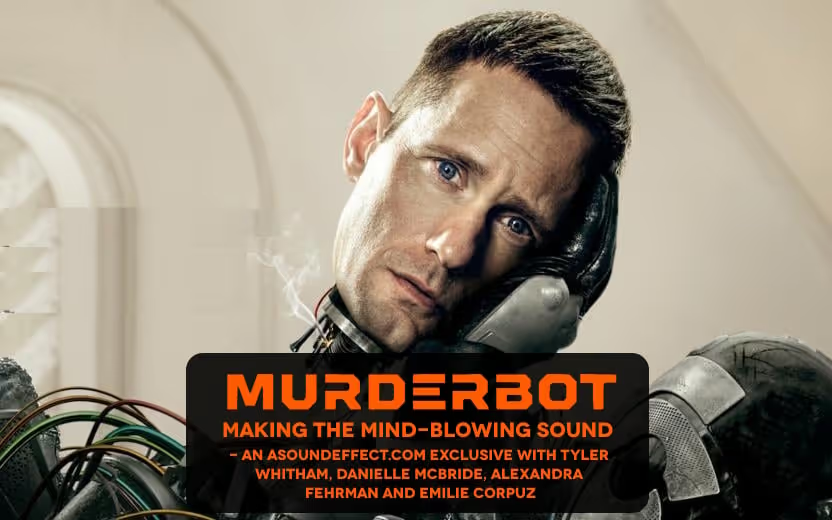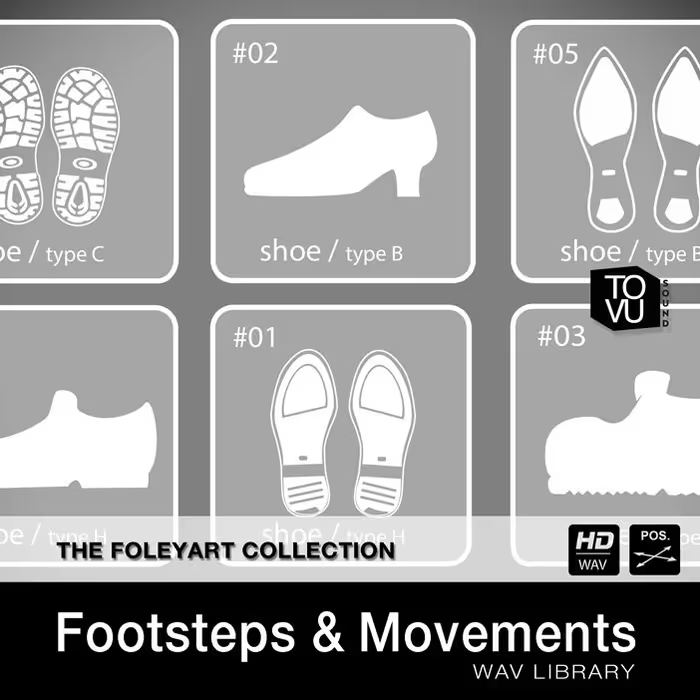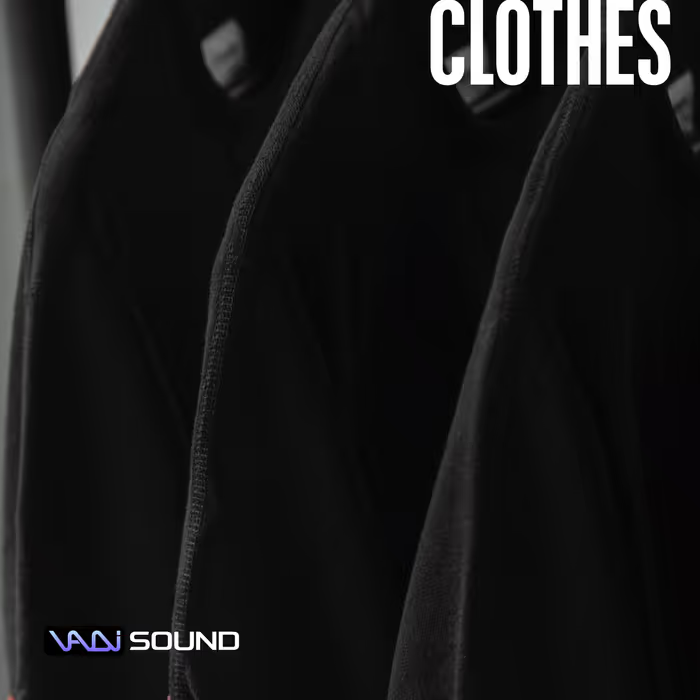Apple TV+ series Murderbot — now streaming — isn’t the typical sci-fi show. The protagonist, Murderbot (played by Alexander Skarsgård), is a security unit android constructed with both robotic and biological components. Murderbot has no gender and is therefore referred to as ‘it’ (instead of he/him). It is not interested in serving humans. It desires free will, and so it sets itself free by deactivating a protocol that makes it subservient to humans. Despite naming itself ‘Murderbot,’ it does not want to harm humans. It just wants to watch its favorite space soap opera, ‘The Rise and Fall of Santuary Moon.’
From the first three minutes of Murderbot‘s opening sequence, it’s apparent that this show is a standout for sound. There are high-tech sounds, like Murderbot’s heads-up display, happening over its voiceover ‘internal monologue’ track, and an incredible score weaving around lively backgrounds with call-outs, and that’s all mixed with overlapping lines of dialogue. It’s an opening scene that will catch any soundie’s ear. And it’s not just the opening scene! The show is filled with numerous ‘wow’ moments for sound.
Here, supervising sound editor Tyler Whitham and co-supervising sound editor Danielle McBride at Sound Dogs in Toronto, and re-recording mixer Alexandra Fehrman and re-recording mixer Emilie Corpuz, who mixed Murderbot at Signature Post between stages in Burbank (Stage 1) and Santa Monica (Stage 5), talk about finding the sound of this sc-fi action-comedy. Their first task was nailing down the sound of Murderbot’s dialogue — how its voiceover sounds, how it sounds through its helmet, how it sounds through its helmet and over comms, how to handle its breaths during combat, and how to mix its internal dialogue over its in-situ dialogue. They talk about designing the sounds for the two-headed sandworms, creating gory, organic sounds with mechanical servos for the SecUnit’s body, building brutal melee moments of SecUnit versus SecUnit, crafting cool tech sounds for the ships, equipment, and weapons, handling the sound of the space soap opera ‘The Rise and Fall of Santuary Moon,’ keeping the comedy in the action, and so much more!
WARNING: MAY CONTAIN SPOILERS
Murderbot — Official Trailer | Apple TV+
When did you start work on Murderbot, and what were some of the first sound elements that show creators Paul Weitz and Chris Weitz wanted to focus on?

Tyler Whitham (TW): I started in the spring of last year. They were still shooting but had some rough cuts with some scenes in place. I got a call from one of our picture editors, Jonathan Corn. He was with us for the whole series, giving his creative input, which was great. Jon called and asked for some sounds for the Hopper (the Preservation Alliance’s transport ship) to put into the Avid, as well as sounds for Murderbot’s arm cannons. I was on vacation at that time, but said I’d take a look and put some ideas together. There weren’t VFX in place yet, so Jon sent some concept art and some pre-viz material so I could start to build some sounds off of that.
This was all based around Ep. 1. Some other things that Chris and Paul wanted to hear (that they felt were lacking in the rough cuts) were some of the atmospheres. I had done a rough-sketched version of the Hopper interior, giving it a sense of motion with rattling and jangling inside there. We also did atmospheres for inside the habitat. Some of the rooms, such as the med bay, needed to feel a bit different. We did some of the exterior locations outside of the habitat, using different winds.
Since it’s the first season of the show, we wanted to get an idea of what this show sounds like. Where can we start with the jumping-off point? So that began in the Spring of 2024, and it evolved from there.

Danielle McBride (DM): They brought me on in June for a two-fold dialogue assignment. Primarily, we were heading into the initial voiceover sessions, so they wanted me to start prepping for that.
Simultaneously, we started moving forward on the voice treatment and finding what the in-helmet treatment was going to sound like. They wanted us to workshop different examples of the vocal treatment.
And believe it or not, at that point, we weren’t even entirely sure what aspects of the voice would be treated. We understood there would be a treatment on the helmet voice, but there were a lot of early conversations about whether we would have a treatment on Murderbot’s speaking voice and on its voiceover voice. There were questions about treating the in-helmet voice and how that treatment would translate into other situations. Would that treatment still be in place when Murderbot is speaking to people on comms? And if we treated the voice without the helmet on, how would that work?
So there were a lot of early conceptual conversations about those sounds and a lot of work in those early summer months (early June through early August). We put forward many ideas to the brothers, Chris and Paul, so they could eventually decide or let us know we’re heading in the right direction.
That was a pretty elaborate process to land where we eventually landed. I’m very pleased with where we’ve gotten to with all of that.
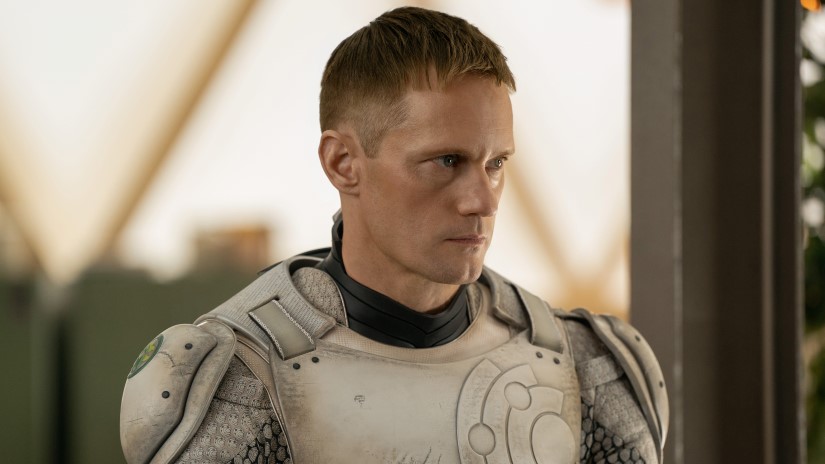
Murderbot’s voiceover is its internal monologue, which sometimes plays over other dialogue/what’s happening in the scene, like the science team checking out the habitat for the first time, or even its own voice, like in Ep. 4 when Murderbot is singing the ‘Sanctuary Moon’ theme song as it’s lying incapacitated on med table and another SecUnit is trying to install a combat override module. Can you talk about your approach to mixing this dialogue?
Alexandra Fehrman (AF): As soon as I was hired for Murderbot, I knew that there were going to be three basic qualities to Alexander Skarsgård’s voice. The first being Murderbot’s voiceover, the second being its “in-helmet voice,” and the third being its on-screen production dialogue.
these qualities would all be distinguishable, especially in the instances where we go from Murderbot’s VO to its regular on-screen dialogue
The filmmakers asked me early on to think of ways I could ensure that these qualities would all be distinguishable, especially in the instances where we go from Murderbot’s VO to its regular on-screen dialogue. We wanted to ensure that the audience could distinguish the voiceover lines from the lines that were intended to be planted in the scene. There was also the fun of adding sounds of sourced comms to both the helmet and non-helmet voices.
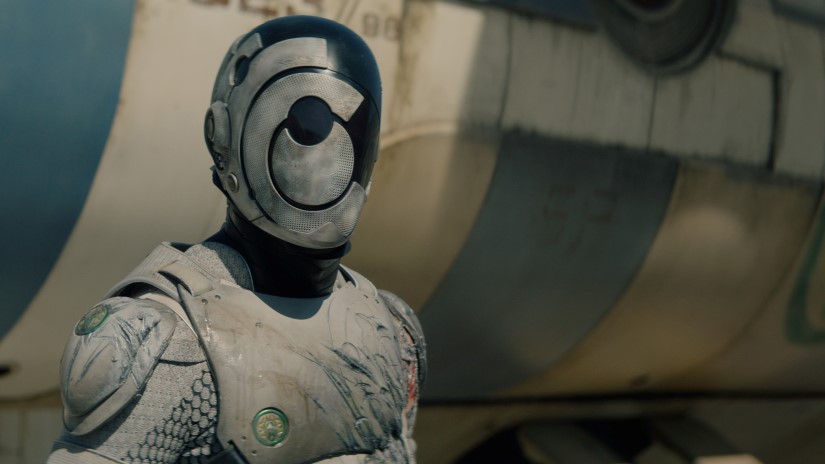
What went into the vocal processing for Murderbot when it has its helmet on?
AF: Initially, the producers asked Tyler [Whitham], Danielle [McBride], and me to submit different options for what Murderbot’s in-helmet sound should be. We submitted samples using various plugins, for example, iZotope VocalSynth, FabFilter Saturn, BABY Audio Humanoid, etc. Tyler designed an option using a plugin called Portal by Output.
Sometimes we were using a mix of ADR and production […] The plugin would also react differently to noisier pieces of dialogue
We developed a workflow. Tyler sent his design profile to me to load in, so I could easily manipulate it during the mix. Sometimes we were using a mix of ADR and production, and since the quality of the dialogue recording was always different, I would change the parameters — not just on the EQ, as I normally would do to match the ADR to production, but also on the vocal treatment plugin to maintain the natural quality. The plugin would also react differently to noisier pieces of dialogue, so I’d use faders and micro adjustments to ride it out when perspectives were much different from each other.
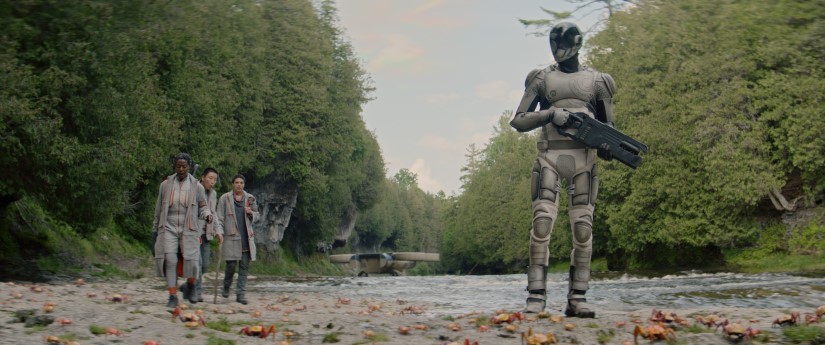
There’s double vocal processing in some of those scenes, like hearing Murderbot through its helmet and through the comms as it’s talking to Mensah, or when it’s making announcements over the habitat’s PA system (like in Ep. 7). That blows my mind!
DM: It blew our minds, too, as we talked it through. In almost every episode, we would reassess and discuss. Are we in the right place with it? Is this what we want to do? Do we have continuity from what we’ve done before? That whole process was really neat because everybody was putting forward ideas. The entire team had a go at it, so the end result was incredibly collaborative.
no matter what we might have come up with creatively, the processing had to be something that was done on the mix stage
And because it was ever-shifting, one of the things we discussed early on was: do we want to bake it in? Do we want this to be something that happens in editorial? But we discovered that, no matter what we might have come up with creatively, the processing had to be something that was done on the mix stage.
To complicate things further, our source material was different. We were dealing with source material that was recorded in ADR, which was always the best option in terms of our flexibility for the treatment. We were also dealing with wild lines from the set, which were incredibly well recorded and easy to work with. On top of that, we were dealing with lines that actor Alexander Skarsgård (who plays Murderbot) said while he was wearing the helmet, which our production sound mixer, Michael LaCroix, had mic’d up.
Michael LaCroix did a great job of capturing that dialogue inside the helmet, so we didn’t replace all of it
Michael LaCroix did a great job of capturing that dialogue inside the helmet, so we didn’t replace all of it. Since we were using that production audio, which already had that internal helmet sound, all the dialogue we did on the ADR stage needed to sound like that as well. All of our source material, whether we did it on the ADR stage or it was done on set, had to sound continuous. Tyler did the lion’s share of checking that. And it created quite a bit of complication for Alexandra [Fehrman], who did an excellent job of making that all work in the mix.
Eventually, once we had a treatment or dialogue sound that Chris and Paul liked, we then applied that to the later scenes that had more production helmet dialogue in them, just to make sure it was going to work.
TW: The first scene we tried was in Ep. 1, when Murderbot is standing at the top of the hill, overwatching the scientists — Arada and Bharadwaj — who are about to be attacked by the sandworm. That was the first time in the series that we hear Murderbot’s helmet treatment, but it was a tricky scene because we were playing with perspective. Since Murderbot is far away, we were playing with reverb and perspective.
We landed on that treatment, and as we got into other scenarios in the season, we were setting our rules (so to speak) for when we’re using this particular filter and when we’re not. We played around with different ideas, and we even played with different pitches for when the helmet is off, or the helmet is on, versus comms, versus not over comms, versus voiceover. It was important to get the differentiation between the helmet processing and the voiceover. We wanted to make sure we heard that distinction.
We found the production sound was making the plugins and our processing react quite differently compared to what we had done in Ep. 1
Things got complicated in Ep. 9 since there was a lot of helmet-on dialogue as Murderbot was meeting with the team sent by GrayCris. It walks up to them and has this big conversation with them on the exterior of the planet, and that’s all production sound. We found the production sound was making the plugins and our processing react quite differently compared to what we had done in Ep. 1. We wanted to make sure that we weren’t going to get sick of this processing if we continued it through that scene. I think Alexandra ended up dialing it back a little bit or dialing it up, depending on each situation.
So, the processing was slightly different, based on the recording. That production dialogue really had a different feel from the ADR, and obviously, from the voiceover.
AF: We had a lot of experimentation playing with the comms, because we wanted to make sure we felt both the texture of being on a futz, in addition to letting the audience know when Murderbot is talking through its helmet, while staying consistent with intelligibility. Once we established the sounds and qualities we liked, I would apply them and sometimes loosen or tighten the parameters depending on what the production audio could handle.
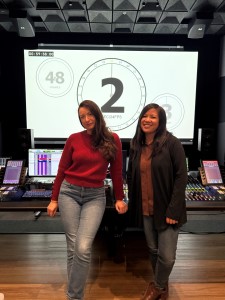
We had a very specific challenge in Ep. 9 when Murderbot is talking out loud to its team in comms and to members of the Corporation Rim behind its helmet. It was important for us to make sure the audience could follow what information it was sharing with the team, and what it was saying to Corporation Rim.
Emilie Corpuz (EC): In Ep. 3, near the end, there’s also a bit of garbling — Murderbot says it caused the static. For that, we added sound effects of static to elevate the intensity of the dropouts.
AF: In those instances where we had static in the comms, we also played with pitch modulation on the dialogue.

What about the mic selections for ADR that’s meant to match production (both in-helmet and without helmet), and for the voiceover?
DM: We actually recorded the voiceover with lav and boom mics, as well as a Neumann U 87. This was something we talked about in advance. Our very first voiceover session was in Stockholm, and then we went to Copenhagen, then to New York City, and we finished up in LA. We understood that a single episode could have (and most do) voiceover from primarily Copenhagen, New York, and LA, so we threw every mic we had at Alex Skarsgård so that we’d have the utmost flexibility in the mix.
we did occasionally find that between the studios, the match from the boom worked better than the U 87 of that particular studio
And although the lav mic turned out to be unnecessary, we did occasionally find that between the studios, the match from the boom worked better than the U 87 of that particular studio (in terms of matching within a particular episode).
I was really happy that we had the foresight to get those extra mics on the voiceover stage, just in case, because they proved useful.
The voiceover was also a collaborative process between Alex Skarsgård and the brothers (Chris and Paul). Additionally, we had the picture editors, the assistant picture editors, myself, and the post coordinators on the sessions. Everybody was able to contribute and offer insight on how things were going to work. In particular, I enjoyed having the picture editors there. Often in the earlier episodes, we were still finding the voice of Murderbot and discovering what those lines should be while we were recording. Having the picture editors there meant they could offer some insight into changes that we could make to the picture if we used a slightly longer or shorter line. So everybody was in that process, working together, and I enjoyed how collaborative that was.
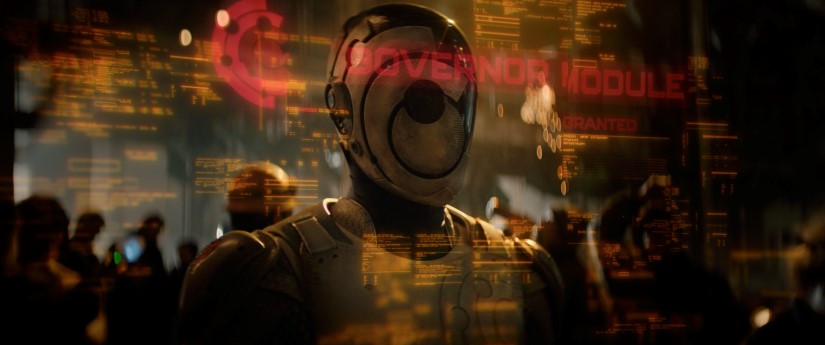
The first episode is so important. It’s the first impression for the audience. It has to grab their attention. It also establishes the tone of the show and sets up audience expectations. And Ep. 1 is packed with sound, from Murderbot’s sounds (like its heads-up display), tech sounds, ship sounds, alien planet sounds, and weapons sounds to (as we just discussed) Murderbot’s dialogue (internal and external). Can you talk about establishing these key sounds?
TW: Like you’re saying, there are so many sounds in Ep. 1. Honestly, I felt like Ep. 1 took just as long to cut as the entire rest of the season. We were so focused on making sure we got it right — got the environments right, got the tech right. We did tons of trial and error as far as how things should sound.
we were cutting in a lot of HUD readouts. The direction for those was to make them feel a bit analog
In Ep. 1, we didn’t realize just how much of the HUD sounds we would hear in the show. When we were getting later cuts with more VFX, we saw there were lots of HUD visuals on screen. I’m glad that we settled on something that was working, and we had set a really good base for what it should sound like. I think we were all happy with it. As the season went on, we were cutting in a lot of HUD readouts. The direction for those was to make them feel a bit analog since Murderbot was a generation behind everything else. We didn’t want to make those sounds too sleek and sexy. Yet, it also had to tell the story of what’s happening in the moment in the scene. Is it an alert? Is this an alarm? Is it a danger warning, or is Murderbot trying to hack into something? So each one had to sound a bit different, and we got them right most of the time. There were a few times when I’d have to find something new because the sound wasn’t giving enough urgency, or enough tension, or it was just annoying.
The base sound for the HUD readouts, specifically, was just a recording of my finger flicking across my keyboard. I was sitting in front of my keyboard, thinking, “What’s the most analog thing I can think of?” and I just flicked my finger across the keys. It worked out great.
There are beeps and bloops in there, too, and each one was very custom and bespoke based on the HUD VFX
There are beeps and bloops in there, too, and each one was very custom and bespoke based on the HUD VFX. For instance, there might be a target that would come up, and we would need a little boop going up or going down. Everything was either pitched up for going in or pitched down for going out — something to give it motion, or to say something’s about to happen, or warn that something bad was happening. I had to make sure the sounds were changing a bit as they were fine-tuning the VFX.

There was a lot of discussion as to who hears these HUD sounds and what point of view we are in that we can hear the heads-up display, because sometimes we were in the point of view of Mensah, or somebody would be talking, and the heads-up display would come up. Does she hear that? Is Murderbot hearing that?
The section of UI sounds in my session was totally outrageous for each HUD VFX moment.
So, much like the voiceover, there were decisions that had to be made and rules that had to be followed and then bent or broken to take creative licenses for who hears it, when we hear it, how loud we hear it, and whether it’s important that we hear it now. Or, is it just there? There was a lot that went into that, on the cutting side and the mixing side, as far as pushing those sounds up when we needed to hear them and tucking them back when we didn’t. The section of UI sounds in my session was totally outrageous for each HUD VFX moment. I’m sure Emilie [Corpuz] (who handled effects in the mix) looked at that and said, “Here we go again.” And it was constant. There were a lot of tracks for the HUD, but it was the only way we could do it.
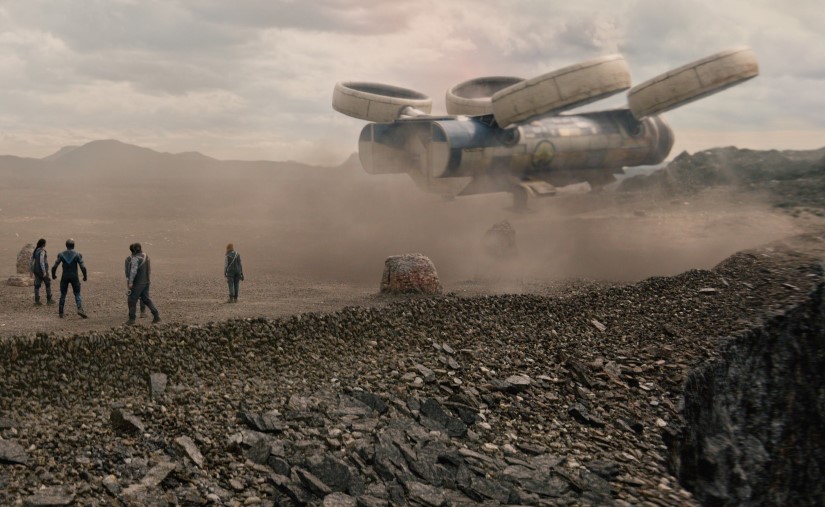
What went into the sound of the Hopper?
TW: This was another early sound we tried to get into the Avid, so everyone was used to the sounds. Once we got into more of the final stage of cutting the Hopper, I ended up with a few key layers that sold it. The base of its motion was made in Soundminer Radium. I often try to build a set of sounds for each vehicle in Radium first, like start/take off, hover/idling, landing/off, as well as an assortment of pass-bys. Then I cut it in and see what could use more layers or if it’s even working.
I even had some pitched-down ultrasonic recordings of hummingbird wings I recorded to give it a bit of that chopper feel
The Hopper is mainly made up of some large machines, like a ski lift starting and increasing in pitch for the take off. That’s layered with some jet wash, as well as some simple tonal signal generators. I even had some pitched-down ultrasonic recordings of hummingbird wings I recorded to give it a bit of that chopper feel. The thing that really cut in the mix was this tonal swell that I made with a granular pitched metal sound to give it this unique, odd character. I also gave it a sputtering kind of feel as it landed because, in some instances, we wanted to remember they were flying in the less sexy version of things.
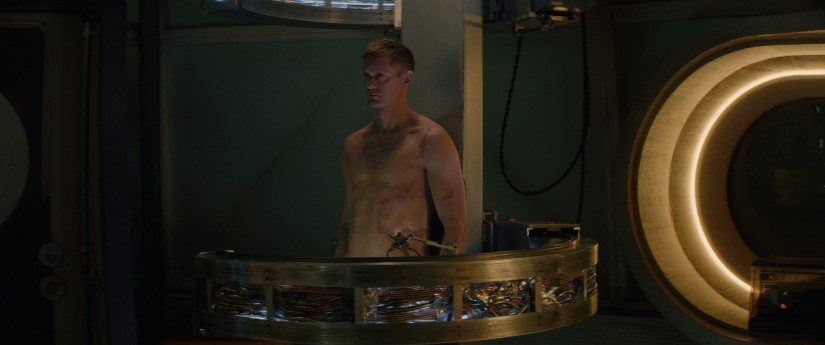
What about some of the other tech sounds, like the SecUnit repair cubicle, or the factory where they created the SecUnits (the Fabrication Center) in Ep. 4? There are cool, gross, fleshy sounds for those crazy machines that print out strips of skin…
TW: The factory required a lot of ambience to bring it to life, so a lot of machines moving, all sorts of servos in the background, like servos from hospital beds and dental chairs.
The robotic arms swinging in were cool. There’s this dental suction-type squeal that Chris and Paul wanted to try for when the robotic arm comes down and it suctions onto a sheet of flesh. There’s comic relief to it. All the characters in the scene are despondent; they have nothing else to give. The tone of the scene is quite somber and depressing. They’re working in this factory making these SecUnit parts, like robot arms and legs. We wanted to juxtapose that with some comedy (but not be cartoony), to have the sounds of the machines offset this environment.
I had prebuilt all the welding pens in Soundminer Radium […] and cut it in for each of the welding pens
We worked hard to make sure everything had a sound to it: the servos for moving parts, the suction sounds, and all the welding. And I had prebuilt all the welding pens in Soundminer Radium — I do a lot of stuff in the Radium sampler — and cut it in for each of the welding pens. It seemed to be a tedious task because there are four people welding, but once you hear it with what’s happening on screen, all at different times and panned to all different positions, it all comes to life.
The SecUnit repair cubicle has all these little robotic legs, and I made it feel cute and fun. It’s moving quickly as Murderbot is just standing there getting repaired, so these little sounds brought some life to it that way. The cubicle has this cauterizing laser and this cooling spray that’s happening. The trickiest part was the motion of it. I started cutting in all the moments of it, the cauterizing and spraying, but making it move back and forth was what gave it some of that life.
I ended up going around my kitchen trying to find a sound for the little tripod leg movements. I found a garlic press and was clattering it back and forth
I ended up going around my kitchen trying to find a sound for the little tripod leg movements. I found a garlic press and was clattering it back and forth. I recorded that sound, trying to get it close to the pace of the movements on screen. I did a bunch of different takes, and then I did a bit of light processing to make it feel a little more sci-fi. That became the basis of the legs moving in and out, which gave it life. All of a sudden, it was moving. We have some little vocal-type sounds for it, kind of pitched servos, that add a sense of life, too.
For the big ring around it, I had these recordings of an MRI machine moving. So, it’s this pitch-down version of this giant machine turning on and off, as if it were healing it with this magnetic kind of pulse to it, just to give a sense of weight and significance to what it was doing to heal Murderbot.
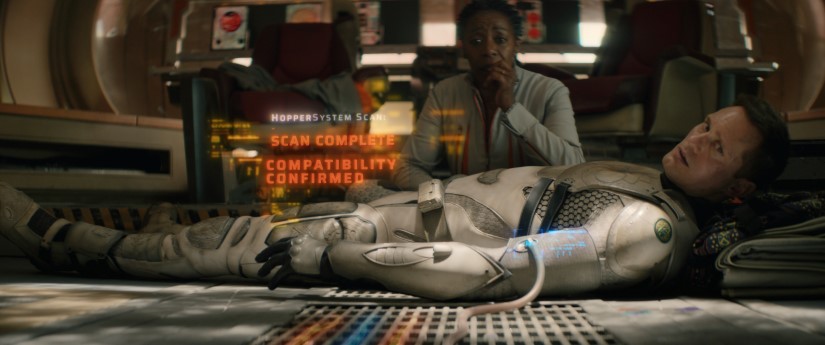
There’s another scene with cool yet gross sounds. In Ep. 6, Mensah operates on Murderbot, cutting into it with a scalpel. I love how the sound changes as she cuts deeper and deeper into its ‘flesh’, and then has to crack open its back with the wrench and pull out a metal vertebrae and a strand of neurofiber….
DM: This was a fun scene to ADR with actress Noma Dumezweni. We mostly filled in little exertions and breaths here and there. Mensah, more than any other character, had a lot of ADR cues for breaths and reactions. Not only this scene, but there are also other scenes with the sandworms where we needed very dramatic non-verbal reactions. Noma was a great sport about all the “emotional breathing” cues she had to do.
TW: That was an early scene I sent some sound to the Avid for because it was pretty specific in sync and texture. Since it was fairly performed, I recorded some simple sounds of a sharp knife cutting into the skin of a banana. Then we just get deeper and more gory as the scene goes on.
Since it was fairly performed, I recorded some simple sounds of a sharp knife cutting into the skin of a banana.
Paul also had this idea to try a “nails on the chalkboard” moment as Mensah pulls the neuro fibers from its spine, so I added a layer of dry ice squeals to help us feel uncomfortable. I will say our foley artist John Elliot provided some really awesome foley detail of the wrench cracking the vertebrae, too.
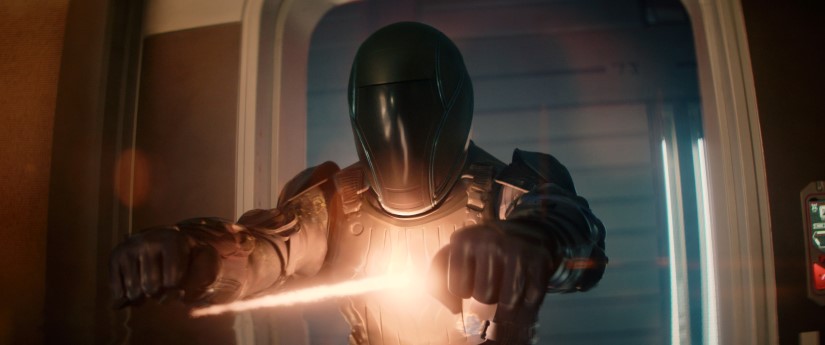
A bit later in Ep. 4, Murderbot has a hand-to-hand fight with another SecUnit that is trying to install a combat override module. Mensah steps in at the end and dispatches the other SecUnit with a gnarly mining drill, so fun!! Can you talk about your sound work for this fight?
TW: The mining drill was something I made mostly in Soundminer. There are so many useful built-in effects right there. I believe I used a recording of my reciprocal saw and added some saturation, bass enhancement, and then a touch of GRM Reson for a more metallic feel, and voila! We had a gnarly mining drill. Also, there’s a ton of gore.
I used a recording of my reciprocal saw and added some saturation, bass enhancement, and then a touch of GRM Reson for a more metallic feel
Sound effects editor Craig MacLellan cut all the hand-to-hand combat for that scene and killed it. We kept adding bigger and heavier impacts to really sell the power each SecUnit delivered in each blow.
EC: In terms of the mix, the clients wanted this section to sound extra violent. I played more of the crunch of the suits, which made the hits more impactful, along with layered metal crashes.

The science team joins the fight against the other SecUnit, using the Hopper ship to pick it up, smash it with the cargo doors, and squish it into the ground under the ship’s landing gear. Can you talk about your sound work for this scene?
TW: A lot of the sounds there shine because of the great work from the mixing team. The music is booming; there’s celebratory shouting from inside the Hopper’s cockpit. And there are the effects. We gave them the tracks, and they made it sound great.
AF: This scene was so exciting, and TONS OF FUN! We had a huge thematic score written by Amanda Jones, on top of screaming characters, but there were also so many sounds that needed to come through in the sound effects to ensure we were following what Murderbot’s experience was during the fight.
The Hopper had to come in as a surprise, so I had to be mindful of quickly making the engine sound loud and dive out for the crush impacts.
EC: The Hopper had to come in as a surprise, so I had to be mindful of quickly making the engine sound loud and dive out for the crush impacts.
TW: The overarching note in the room on that day was, “Can we go bigger on the ship crashing down?” So we went a little bigger, and then even bigger. Chris and Paul were like, “Really go for it.” So, we went for it.
There were so many different elements in the whole sequence. We had the guns, the heads-up display happening because Murderbot had the combat override module in the back of its neck, we have the Hopper sounds, the production dialogue, and we have its voiceover that Danielle recorded and edited. There were so many elements, and we’re trying to hit the drama, the action, and the comedy of it.
There were so many elements, and we’re trying to hit the drama, the action, and the comedy of it.
Ratthi ends up knocking himself out with the gun’s recoil. I worked so hard on dialing up the charge sound on his gun. I swear I must have made 400 different charge-ups for the series. For this one, he charges it and it goes halfway, and then I need to do an extra charge, and that was the comedy factor of “oh man, what’s he gonna get into?” Sure enough, he fires the weapon and hits himself in the head.
It’s hitting all those moments, and there was a rhythm to it, right? There was an explosion over here, and then the antagonist SecUnit walks up, then Ratthi fires the gun, which hits him in the head. Ratthi falls to the ground. Then the action moves over here. Every second, there’s a different sound trying to poke through the action music track, but we need to hear what they’re saying. So it was probably more of a mix challenge than it was editorially. We supplied it, like I said, but really, the mixers did a good job of making it all shine.
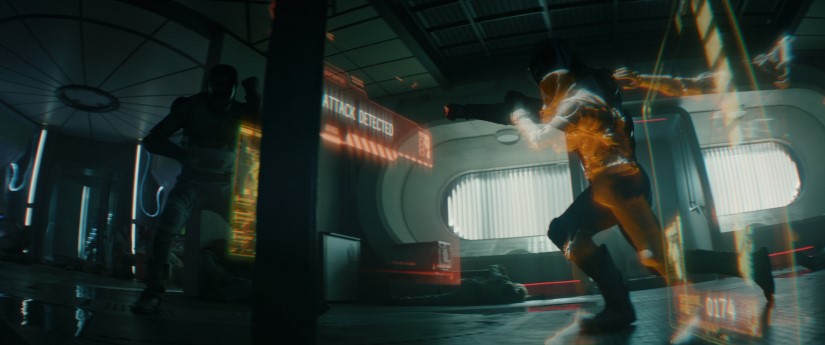
Going back to Ep. 3, can you talk about that fight between Murderbot and the SecUnit? What went into the sound work for this scene?
DM: One of the fun discussions we had was: should we hear fight exertions from Murderbot and the other SecUnits? I knew from reading the books that Murderbot does breathe, but would that be an element in the show? We eventually decided that we would hear its exertions and reactions during the fights when its helmet was off, but not when it was on. And, since we never saw the other SecUnits fighting with their helmets off, they remained quiet.
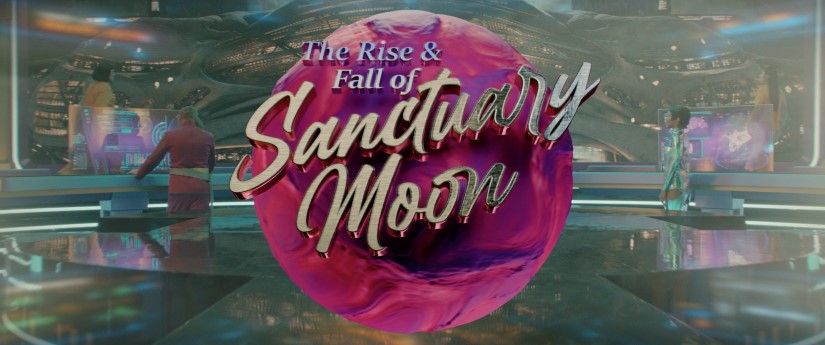
What went into the sound of the space soap opera “The Rise and Fall of Sanctuary Moon”? This is like a series inside the series, and it has a unique vibe that’s very different from Murderbot…
TW: On the effects side, the direction was to go somewhat cheesy. Everything was over the top. It has some of the most hilarious lines that were delivered in the most over-the-top way. For me, it was like, let’s match that with sound. When the “Sanctuary Moon” spaceship flies in, I made this almost The Jetsons-esque, bubbling kind of sound because it’s this ridiculous soap opera and not real life.
When the “Sanctuary Moon” spaceship flies in, I made this almost ‘The Jetsons’-esque, bubbling kind of sound
In one episode, they’ve got this healing-pulse laser gun, and I thought, “Let’s go over the top of that.” Sound effects editor Craig [MacLellan] came up with the sound for that. He sent it to me, and it was so close. It just needed one more layer. So he put in this high-pitched element that really cut through, and it was a chef’s kiss. It’s so ridiculous. It’s perfect. From a sound effects and design point of view, we just went for it. Everybody seemed to be catching the same vibe. So much of it was already on the screen for us.
we had flowing seaweed plants that we used on the exterior to make the atmosphere feel unique
EC: In terms of mixing the effects, everything was a little more heightened for a soapy comedic effect, and the background sounds were otherworldly. For example, we had flowing seaweed plants that we used on the exterior to make the atmosphere feel unique. There was also a lot of VFX information to draw from, like for example, the on-screen giant wormholes. I’m remembering now that when they entered the wormhole, there were visual hits that we matched with sound effects, which were also very fun because of their slapstick nature.
DM: On the dialogue side, it was just a matter of cleaning it up and keeping those performances. We did add a little bit of fun, over-the-top loop group in some scenes to just heighten the ridiculousness of it all. But the comedy was pretty much all on screen, and it was so well written and performed, we were just complementing it rather than creating it.
AF: On the dialogue and music mix, we definitely played up the drama. We used bigger swells in the music score to achieve more of a soap opera-style mix, and we mixed the dialogue to be more in front.
TW: The music for “Sanctuary Moon” was great. Everything was really landing as far as the comedy.
DM: Our composer, Amanda Jones, was just incredible. She contributed so much to the show. The score was fantastic.
TW: She’d done this theme song for “Sanctuary Moon” that became a big player later on in the show. Murderbot gets the garbage kicked out of it (again!), and it’s on its last leg, so to speak. It’s running through the “Sanctuary Moon” opening, but since Murderbot is damaged, it’s glitchy and warped.
I had done a version with old cassette-type warbling, where it was verbing out as Murderbot is coming in and out of consciousness.
We spent a ton of time on the mix stage doing this wavering pitch/distorted version of it, and reverbing it out. It was really cool. The picture editorial side had done a great temp to match, and the music editor had done a version. I had done a version with old cassette-type warbling, where it was verbing out as Murderbot is coming in and out of consciousness.
The “Sanctuary Moon” theme song was this earworm. I would be sitting there at night, singing it.
DM: It became a joke in itself when it would appear in these later moments because it became so identifiable. It was such a great little tune. You start to hear it, and it would already have an emotional significance at that point, like a humorous emotional significance.
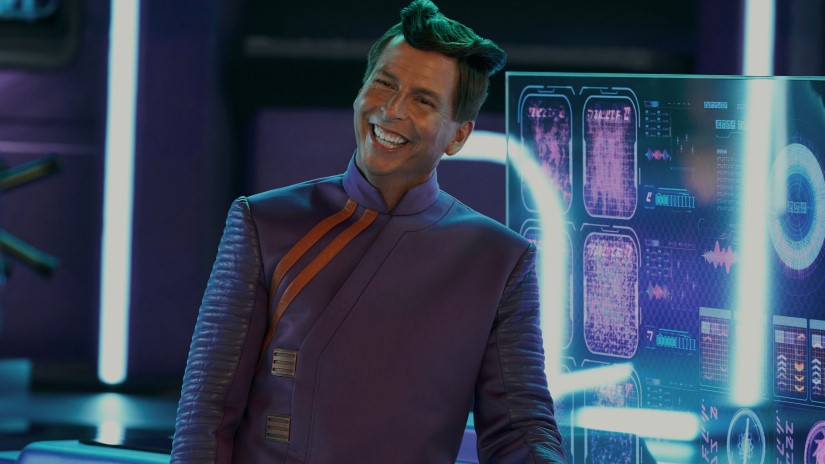
How did you handle the transitions in and out of the space soap opera “The Rise and Fall of Sanctuary Moon”?
EC: There were typically a few layers of sound design to choose from, like tonal pitches and reverse boom elements to enhance the mood of the particular scene transitions.
AF: We also swelled music transitions, anticipating the cut, leading up to drop-offs, and often at times used a lot of short plate reverbs, with the intent to quickly return to reality but not jarringly.
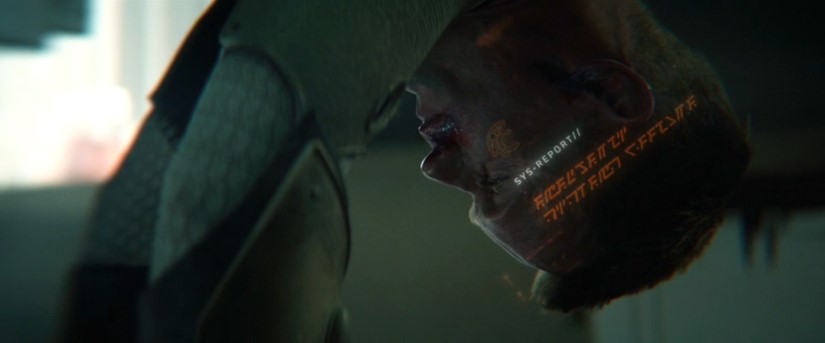
We previously mentioned that moment in Ep. 4, when Murderbot is singing the “Sanctuary Moon” theme song while preparing to fight the other SecUnit. But I have to go back to this. Not only do we hear Murderbot singing in the room, but at the same time, we hear its voiceover narrating what it’s thinking. There’s also the sound of its glitched-out HUD and score! There’s so much sound happening in just that one moment…
DM: We would have discussions with Chris and Paul, and I remember thinking that it was amazing how they could conceptualize all these layers of sound that I didn’t think would be possible. They’d say, “I want to hear this and hear that and hear this and that.” I thought, “How are we going to make all that play?” It’s a credit to their imagination, and it’s a credit to what Tyler brought to the screen with all those layers, and of course, it’s a credit to the wonderful work of Emilie and Alexandra that those layers work. You hear everything.
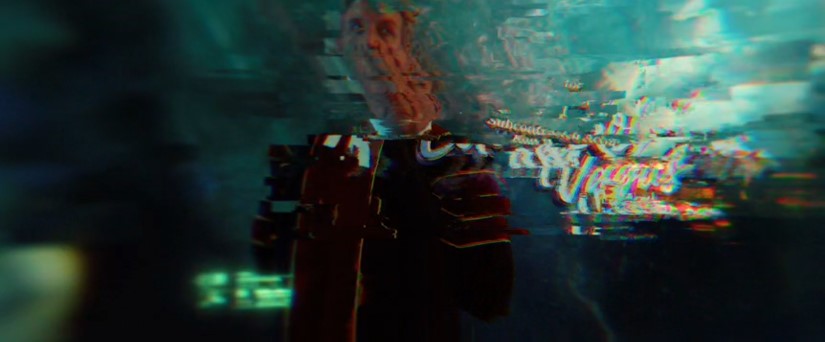
There’s another cool moment in the sequence when Murderbot is damaged and it memory keeps dumping its most-used data into it, which ends up being episodes of ‘Sanctuary Moon,’ only they’re all glitchy and warped. Can you talk about your mix on this scene?
AF: We had a lot of great material to work with from Tyler and Danielle. Emilie and I took time to sync up our sonic builds to create a call and response between the sound effects and clips of the “Sanctuary Moon” show within. It was so exciting to play with the warping and make each clip feel separate and like they’re being sifted through.
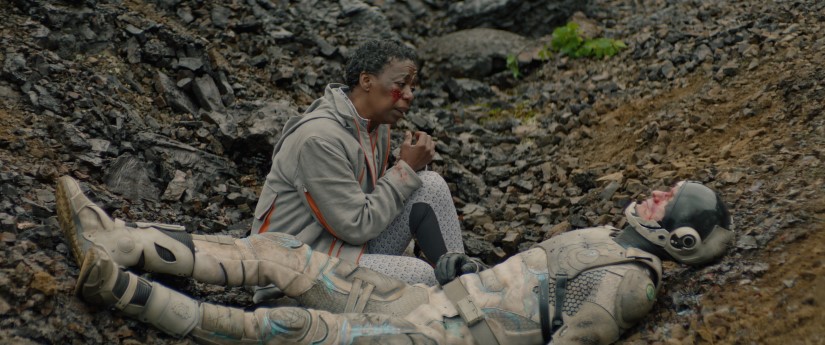
At the end of Ep. 9, there’s this slowed-time perspective as the beacon is launched. Murderbot gets severely damaged, yet saves Mensah. The science team celebrates, and Murderbot ‘goes offline.’ Can you talk about mixing this sequence?
AF: At times, we definitely considered stripping sound away and bringing it back with the action. We wanted to feel the emotion of Murderbot going offline, so we subtly faded down some of the surrounding ambient sounds to focus in on it. There were also a lot of cutbacks throughout this sequence, and we wanted to make sure each perspective was accurate.
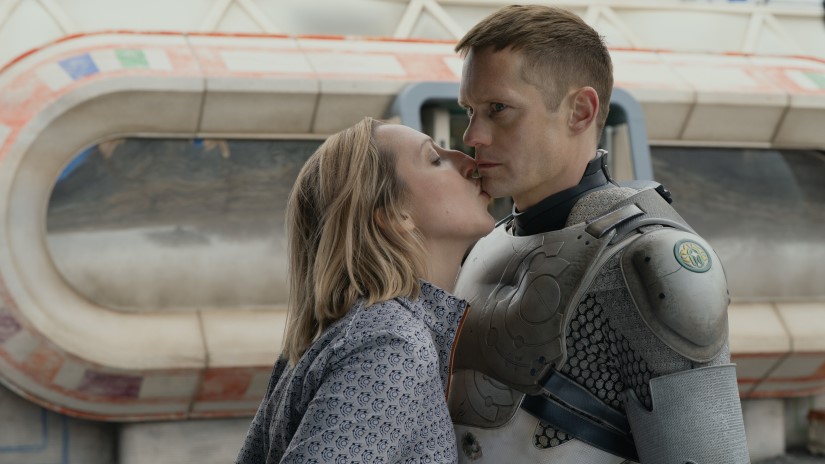
Did you have a favorite episode to mix, and what were some of your favorite moments for sound?
EC: Ep. 9 was probably my favorite as far as action and pace; anytime there were any Murderbot flashback sequences, it was exciting to play with the sound design. Also, Ep. 5, when Leebeebee awkwardly kisses Murderbot, I mixed in a nose hit, because it truly makes me laugh every time, and I thought the audience would feel the same.
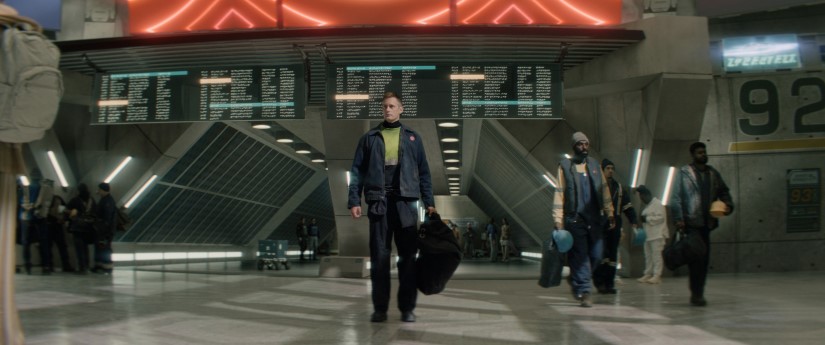
AF: I truly love this show, and it’s so hard for me to pick, but I think Ep. 10 is my favorite because we had previously gone on this journey, and now we have to say goodbye to these flawed yet sensible people who have had an adventure with Murderbot. We also revisited the main hub, with the comical overhead pages, and the scene where Mensah discovers Murderbot has gone gets me every time!!
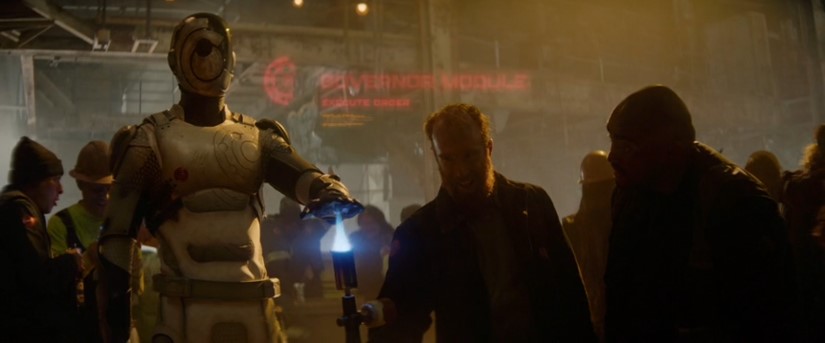
If you had to pick one scene that best represents your dialogue work on Murderbot, what scene would that be and why?
DM: The one scene that stands out to me is the first scene in the series — Murderbot as a typical SecUnit who’s present with the mining colonists who are celebrating that their work is complete and they can leave that planet. It certainly was the most fun. There are so many elements.
First off, we were working out the voiceover, but we didn’t really have it yet. So that became a continuous thing that we worked on, gradually pulling it together until we got the amazing performance we got.
My loop group must have spent three and a half hours just playing with the individual specifics of what we’re seeing in those opening two minutes.
Underneath that was a lot of loop group (something we didn’t have often on this show). The loop group just had fun with it. We brought in as many people as we could. We picked up as many specific, little elements as we could. And they’re all in there. My loop group must have spent three and a half hours just playing with the individual specifics of what we’re seeing in those opening two minutes. We have the woman riding the little car-type thing, and her little “Yeah!” that she does. We have the guys fighting, and the guy who falls into Murderbot.
And my goodness, we couldn’t get that sound of him falling into Murderbot. The note was always “bigger.”
TW: That’s an important thing you mentioned, Danielle. The sound of when the guy gets pushed into Murderbot, although it seems insignificant, played an important role in the show. It couldn’t sound too metal-y because Murderbot is made up of an organic outer layer. So, it can’t sound all metal and servos, and clink-clunk like a robot. We had to make sure that there’s this organic sort of feel to it.
it can’t sound all metal and servos, and clink-clunk like a robot
I had prepped a giant frying pan clang on it, but that wasn’t right. Again, this is a credit to Chris and Paul, who wanted to make sure that we’re feeling some sort of tissue, but also wires and lubricants. It can’t feel too metallic. It needs to feel human. The audience members need to connect throughout the series with Murderbot on a more emotional level, so it can’t sound full robot. So that first hit was really important. It was setting the scene for finding our sonic signature of Murderbot and what it’s all about. We had lots of discussions on how to make Murderbot relatable because, by Ep. 10, there’s this heart-wrenching moment. It would’ve been a totally different experience if we had gone through making Murderbot sound more metallic.
DM: That hit was also important because it established that Murderbot is immovable. It’s something that a full human body impact can’t push over. Murderbot doesn’t budge. That was a significant aspect of establishing who Murderbot is. So much of who Murderbot is gets established in those first two minutes of the show, and on so many different levels. We establish that it does experience pain, but it doesn’t flinch from the pain. And regardless of how it feels about it, it has to do stuff that people tell it to do. It’s in the SecUnit programming.
We still had some revisions on it while we were on the mix stage, because so much has to happen in terms of telling the audience who Murderbot is.
We were still finding that scene quite late in the process. We still had some revisions on it while we were on the mix stage, because so much has to happen in terms of telling the audience who Murderbot is. That’s the only scene where we see (other than the flashbacks) what its life was like before it got to work with the Preservation Alliance people. So much had to be established in that scene, like the chaos and ridiculousness of what its job was like. That’s why we went so hard with the loop group, to get that contrast of the conditions of its former job with the mining colony compared to its current job with Preservation Alliance — to go from this raucous environment in the opening scene to it standing on a quiet hillside away from everybody.
So, that opening scene stands out to me, and I’m just really pleased with how it came out.
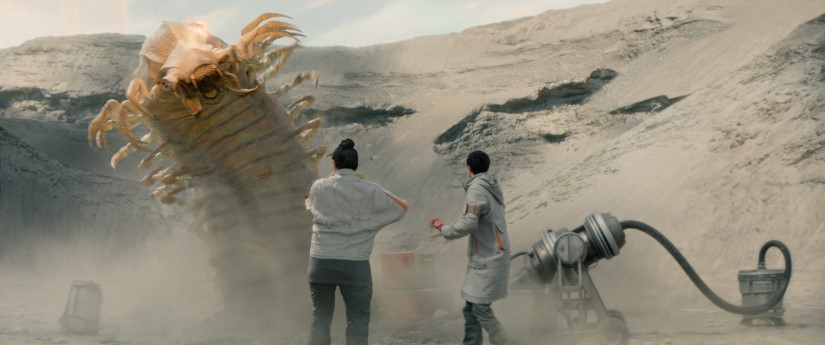
What was the most challenging episode or scene for sound design? What went into it?
TW: Every episode was busy, so every episode had its challenges because there was a lot of action. But I think the most challenging thing was just establishing our worlds and establishing our tech and setting that up. Ep. 1 was so involved; it touched on everything.
There’s a big sand worm/centipede-type thing, which comes back another three times in the season
There’s a big sand worm/centipede-type thing, which comes back another three times in the season. So, we needed to establish that right off the bat. The sandworm was a lot of fun and a lot of work. We played with the placement of screams and types of screams. I had to create something that vocally we could have two of because it has two heads — one that’s the mama head, one that’s the baby head, or at least that’s how I thought of it and treated it. So the screams had to be scalable down to a baby scream, so it was big and small.
It had to show emotion because we go through all sorts of things with these sandworms. In one episode, it’s dying. In one episode, it’s pissed off, and it gets shot. And then in another episode, we have a little bit of sympathy for it as it collects its eggs. In one of the episodes, it’s making love to another sandworm, so there’s the male and the female. That was a hilarious moment. So there were a lot of different sounds that all live in the same palette.
our foley artist, John Elliot […] brought so much of that sandworm to life.
I have to talk about the work of our foley artist, John Elliot. He brought so much of that sandworm to life. It was early in the process, so we were just seeing gray-scale art, but the idea was that it had these articulating plates that move, and all these feet. We had a couple of back-and-forth tries of it, and then he sent me just the sound of the plates. It was three or four layers of just the outer shell moving. It was fantastic. It was the movement sound that glued everything together. It gave it the performance, and it gave it the quality of this almost ceramic kind of feel.
He delivered four layers for the feet. It had such great sync and motion, and sold this idea that there are a hundred feet all moving at once. I was able to use that sync as the template and cut in sounds I’d built in Radium, like some giant body falls and massive impacts to add weight. The sync of the foley footsteps triggered the MIDI for the sounds I created. Then, we added some EQ and saturation to make those foley footsteps bigger.
he sync of the foley footsteps triggered the MIDI for the sounds I created
When you combine the footsteps with the articulating plates and the vocals, all of a sudden, it comes to life.
We had a great team. As I mentioned, Craig MacLellan and John Elliot, and our assistant Stefana Fratila. She was great in helping out with some of this stuff, too. The re-recording mixers elevated all of our work. It was a good collaborative effort.

Overall, what were some of your biggest challenges in terms of mix on Murderbot?
EC: In particular, for me, the sandworm sequences and digital flashbacks were a challenge. They had such big parts to set up at the beginning, so getting the vocalizations and impacts right around the VO and music required a lot of weaving and collaboration with the clients to make sure the story points come across.
getting the vocalizations and impacts right around the VO and music required a lot of weaving and collaboration
AF: The biggest challenge for me was the first episode’s opening scene. We were introducing so many sonic concepts, and there was a lot happening in the scene. We wanted to make it apparent that we were in a giant warehouse party with overhead announcements to establish the backstory for why Murderbot feels the way it does. All of this happened during its initial voiceover, so it was a challenge to sculpt the world — as well as our main character — aurally, all while still making sure the story points were highlighted.
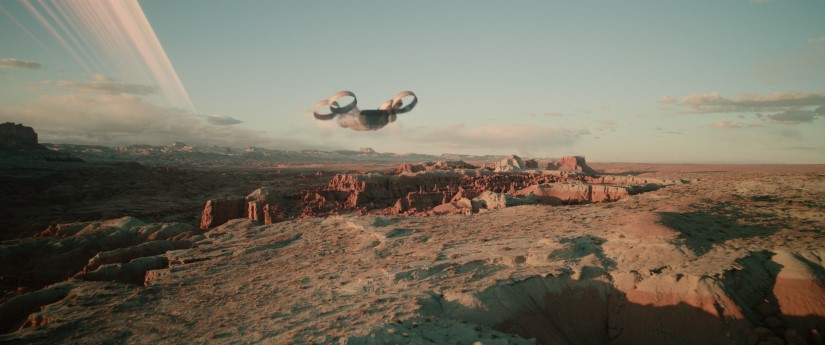
Did you mix in Dolby Atmos natively? What were the benefits of mixing this sound-intensive show in Atmos? How were you able to take advantage of this surround format for Murderbot?
EC: We did mix in Dolby Atmos. For sound effects, there were several opportunities to utilize the overheads with the Hopper flyovers and atmosphere. I mixed in a 7.1.6 template with no objects, but I used Slapper 2 by The Cargo Cult a lot in order to pan and reverb match to the discrete speakers. Playing with perspectives on the sandworms and science fiction design in the Dolby format makes it even more fun and translates nicely to the stereo foldowns.
AF: I feel grateful that this show was mixed in Atmos. We did have a lot of opportunities to use space, and I am happy with the way it folded down.
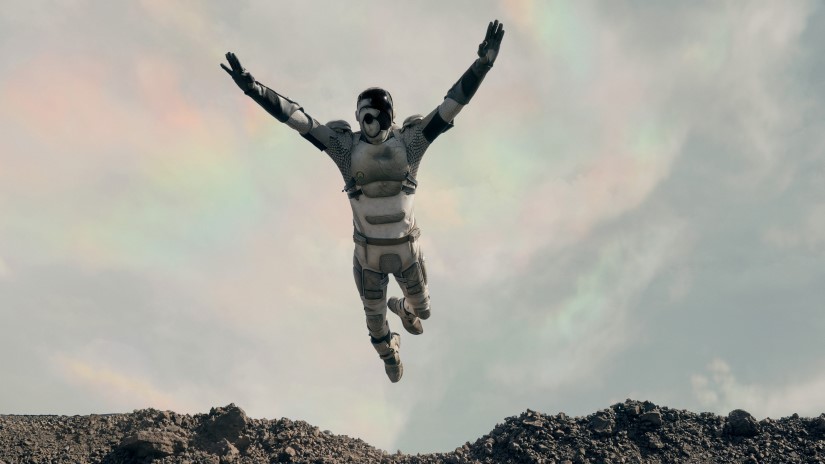
What have you learned while editing sound on Murderbot? Or, what will stick with you most from this experience?
TW: Action-comedy hasn’t always been my forte. It’s usually something a little more cinematic. Working on other shows, they’ve wanted to make it big and make it loud. And so now, introducing some of the comedy aspects to it, I’ve learned a lot. I felt like I had to check myself a lot of the time: are the jokes landing? Does it still sound cool? Is it only cool, but now it’s not funny anymore? You have to take some of the cool out and add something to make it funny. We had a great team who could tell us that’s not funny. It’s not landing quite as well as I thought.
Action-comedy hasn’t always been my forte […] I had to check myself a lot of the time: are the jokes landing?
We had a great roadmap, especially from Jon in picture editorial. He’d say, “Hey, in the temp we had this sound.” Maybe I didn’t see the significance of it, or I didn’t think it was important at the time. And then we’d either add something back in from the temp or build upon that idea, and I totally get where we’re going with this now, and it changes the scene entirely. Sometimes you just put the blinders on and make something big and cool, and it goes in a completely different direction. So that’s what I learned most from this show, hitting the comedy points.
DM: What stuck with me the most from this experience was the incredible pleasure of getting to work on something I was already a fan of beforehand. The books “The Murderbot Diaries” by Martha Wells got me through the pandemic. When I found out I was going to be working on the show, I was coming to it with that knowledge. My first question for our post producer was, “What are we going to do about that voiceover? How are we going to find the voice of Murderbot?”
truly finding Murderbot’s voice happened in the post process.
So much of it was just getting out of the way of Chris, Paul, and Alexander Skarsgård as they found that voice. This was fully realized mostly in post-production. There were temp lines from production, but truly finding Murderbot’s voice happened in the post process. It was incredible to see how much a show can take shape in the post process.
Tyler’s work, my team’s work (with dialogue editor Ève Corrêa-Guedes), and the wonderful work of Alexandra and Emilie on the mix stage. Everybody brought so much to this and was working at the top of their game to make this show happen. Getting to see that happen, while being a fan of it, to see the love that people put into it to really make sure that we got it right was an incredible experience. And I feel that we really did get it right. That’s going to stay with me forever. It’s rare that you get to work on something that you’re already a fan of.
TW: Also, our post producer, Amanda Lencioni Barnett, had so much creative input and a feeling for the show early on. She was amazing. She’d say, “Before we present that, let’s have options.”
DM: She had the pulse of what the brothers were looking for. We’re coming in later in the process, and she was more involved in the picture edit with Jon and Kindra Marra, who were on months before we got involved. You don’t always get resources like that working together. It functioned very well on this show.
A big thanks to Tyler Whitham, Danielle McBride, Alexandra Fehrman, and Emilie Corpuz for giving us a behind-the-scenes look at the sound of Murderbot and to Jennifer Walden for the interview!

